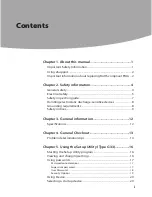
CCpilot XM and CrossCore XM - Software guide
Revision: 1.6
Software Guide
Date: Jun 24, 13
www.maximatecc.com
8.
Linux specifics
This section describes specific details for systems running Linux.
8.1.
Linux system content
The Linux operating system is an Ubuntu LTS (lucid) derivate, using customized desktop and
slimmed contents with limitations in package management, together with a real-time kernel and
interfaces to access the XM device specific hardware and functionality.
Additionally, the file system is changed to a union file system, making the real root file system write
protected where all system changes are normally only valid for one session.
To see which software packages are installed in the XM device Linux system, list them with the
following command:
# dp kg - l
For general Ubuntu setup and system configuration, please see the Ubuntu documentation.
8.1.1.
Linux drivers
Dated 2012-03-01, the Linux driver content is as follows, i.e. this specifies the 3
rd
party software
that is used in XM device:
Usage
Provider
Driver
Graphics
Intel
EMGD v 1.5.1742
8.2.
Updating system software
System software can be updated either writing complete new disk image or install updated
packages. The preferred method is to use package based updates.
8.2.1.
Image based update
With this method all the user modifications to the system will be erased. Device will be set to same
state as it would be when left from factory. This method can be used to recover devices that for
some reason have corrupted system software. This is also simplified with the tools mentioned in
[9].
Boot the device from Linux LiveCD – image, for example Ubuntu LiveCD. If an update LiveCD –
image, containing update system image, is provided, use it instead. USB – boot device is needed to
be selected during boot up at BIOS screen by pressing F11 key.
After device has done booting the Live Linux system, start terminal from menu Applications ›
Accessories › Terminal. Use the following command in terminal to write image from network. In
this example version 1.2.0.0 is used, but it should be replaced to match current version, as well as
replacing the correct path to the actual image file.
#
ss h us er @c om pu te r ‘ ca t pa th /t o/ im ag e/ c cp
-x m- li nu x-
v 1 .2 .0 .0 .g z’ | g zi
p
–
d | su do d d of =/ de v /s da b s= 10 0M
After that command, the system will ask for a password and then start writing the image. Image
writing takes a few minutes in which time nothing will be printed on screen. After image writing is
complete, the unit should be shutdown. Take out the USB-memory stick and start the device.













































